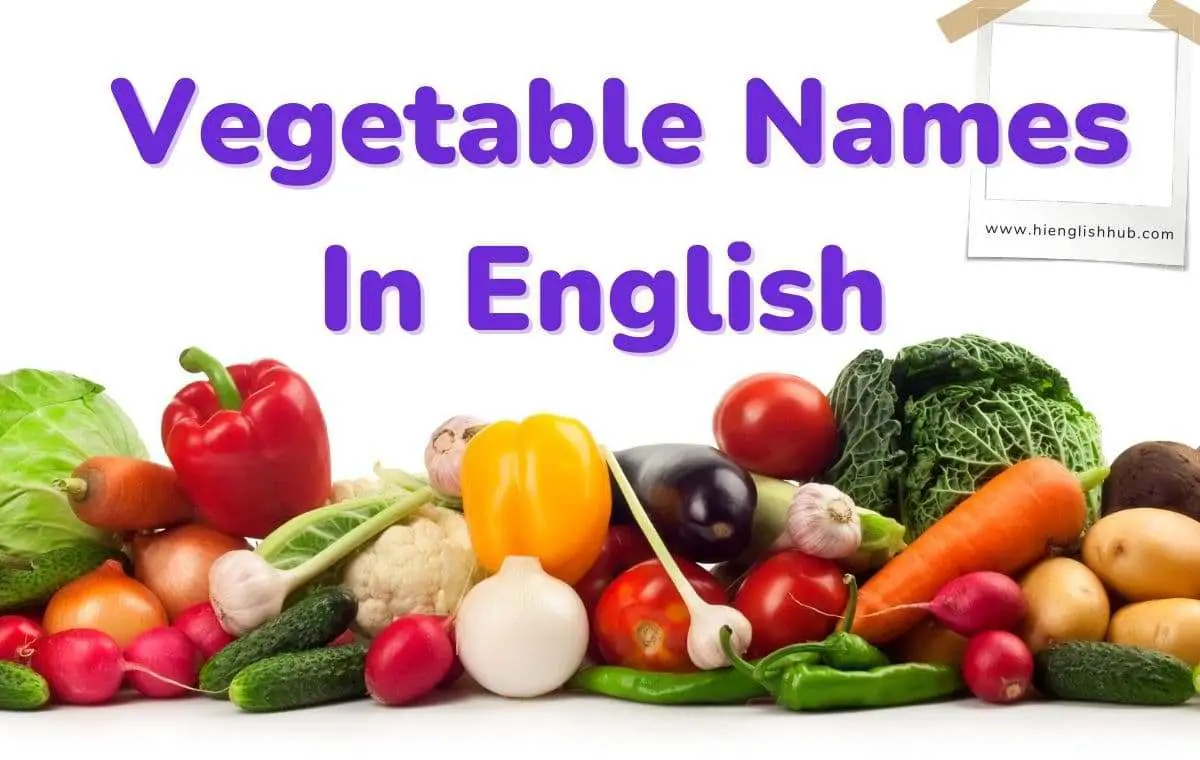Remember last time we had fun playing around with numbers from 1 to 100, figuring out how to spell them in English? We loved how you guys nailed the challenge and started spelling numbers like pros.
Well, buckle up because today, we’re off on a totally different adventure. We’re gonna roll up our sleeves and get our hands dirty in the fun and colorful world of vegetables—in English!
Sidenote:
The Importance Of Learning Vegetable Names In English
So, you’re probably thinking, “Why should I learn the English names for veggies?” It’s a good question.
Picture this. You’re on a trip abroad, navigating a bustling local market. You want to cook something authentic, but when you see ‘broccoli’ in the recipe, you’re at a loss. Not knowing your veggies could turn a fun cooking experience into a stressful one!
And it’s not just when you’re traveling. Even at home, trying out a new recipe could be a challenge if ‘kale’ or ‘spinach’ sounds alien to you. Messing up the ingredients can certainly lead to an unexpected twist in the flavor!
Then, of course, there’s online shopping. When you’re scrolling through Amazon to buy fresh veggies, and you can’t tell your ‘beets’ from your ‘radishes,’ you might end up with a salad that’s, well… a surprise to your taste buds.
So, in all these situations, knowing your English vegetable names is a real game-changer.
Ready to explore our virtual vegetable garden and add some fresh, crunchy words to your English vocabulary?
Let’s dive right into today’s juicy topic—Vegetable Names in English. And off we go!
Vegetable Name List
20 Vegetable Names In English With Pictures
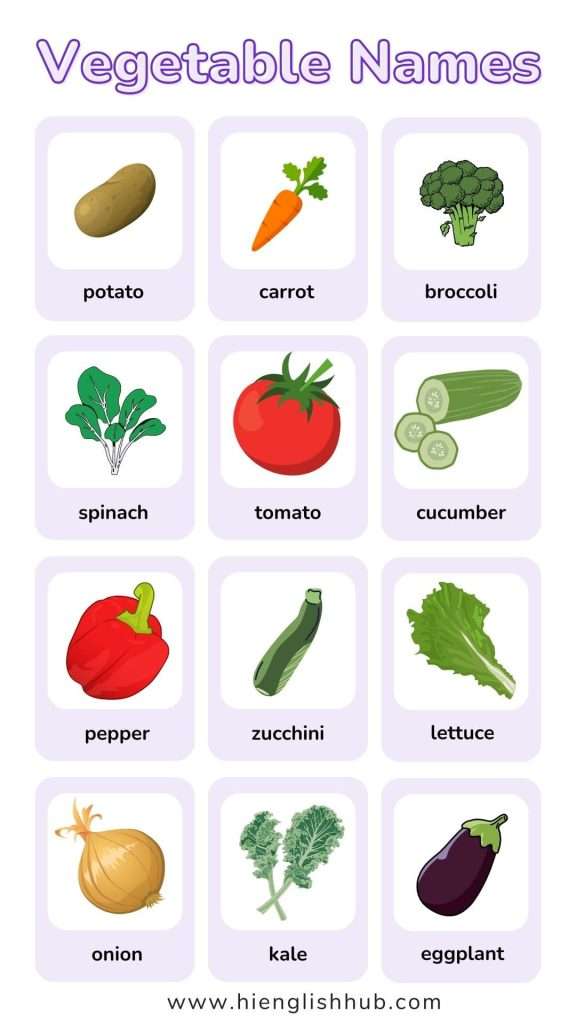
- Potato – This is a popular tuber with brown or reddish skin and starchy inside. They’re extremely versatile and can be used in a multitude of dishes.
- Carrot – This root vegetable is typically orange but can also be purple, red, white, or yellow. Carrots have a crisp texture and sweet taste.
- Broccoli – This green vegetable, which has a large flowering head, is high in dietary fiber and vitamin C.
- Spinach – A leafy green vegetable that can be eaten raw or cooked, it’s a rich source of iron, vitamin A, and calcium.
- Tomato – Technically a fruit, tomatoes are commonly used as a vegetable in cooking. They are red when ripe and have a sweet-tart flavor.
- Cucumber – These are often used in salads and pickling. They are long, green, and have a mild flavor.
- Pepper – Available in a range of colors from green to red to yellow, peppers can be sweet or spicy.
- Zucchini – This is a type of summer squash that’s green and typically used in cooking, although it can be eaten raw.
- Lettuce – This leafy green vegetable is often used in salads and on sandwiches. There are many varieties, including iceberg, romaine, and butterhead.
- Onion – This bulbous root vegetable is often used as a base for cooking and adds a savory depth to dishes.
- Kale – A type of leafy green, kale is packed with nutrients and is often used in salads and smoothies.
- Eggplant – This purple, spongy vegetable is often used in cooking and can absorb flavors very well.
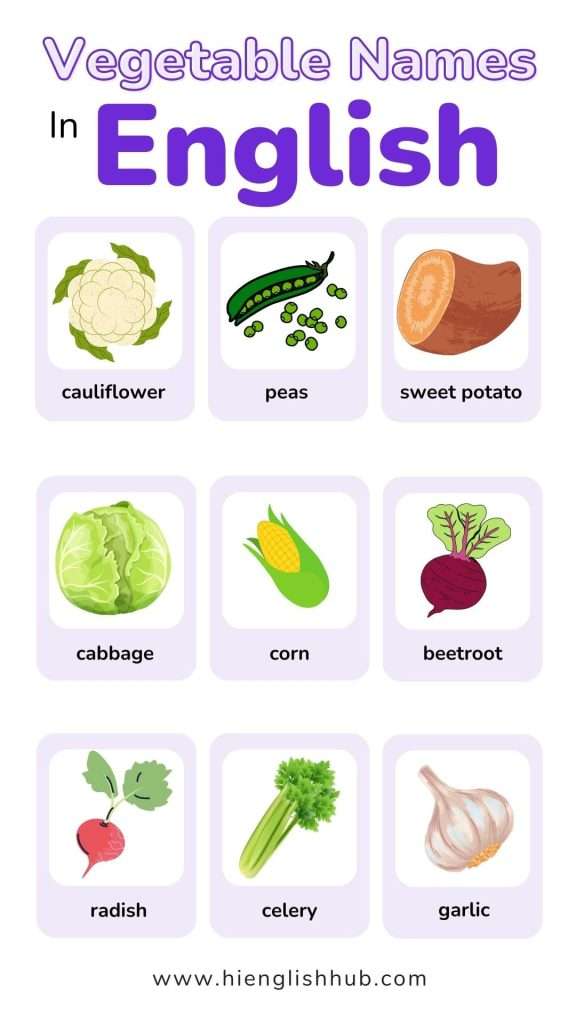
- Cauliflower – A vegetable with a large white head or “curd,” often used as a low-carb substitute in recipes.
- Peas – These small green spheres are seeds that come in a pod. They’re sweet and are often eaten as a side dish.
- Sweet Potato – Similar to potatoes, but with a sweet taste and orange flesh. They’re often baked or made into fries.
- Cabbage – A round vegetable with layers of leaves. It can be eaten raw or cooked and is often used in coleslaw or sauerkraut.
- Corn – This vegetable grows on a cob and is often eaten off the cob or used as a grain.
- Beetroot – A dark red root vegetable with a sweet, earthy flavor. It can be eaten raw or cooked and is often used in salads.
- Radish – A root vegetable that’s typically red on the outside and white on the inside. It has a peppery flavor and can be eaten raw.
- Celery – This green vegetable is long and has a fibrous stalk. It’s crunchy and has a mild salty flavor.
10 Vegetable Names In English With Pictures
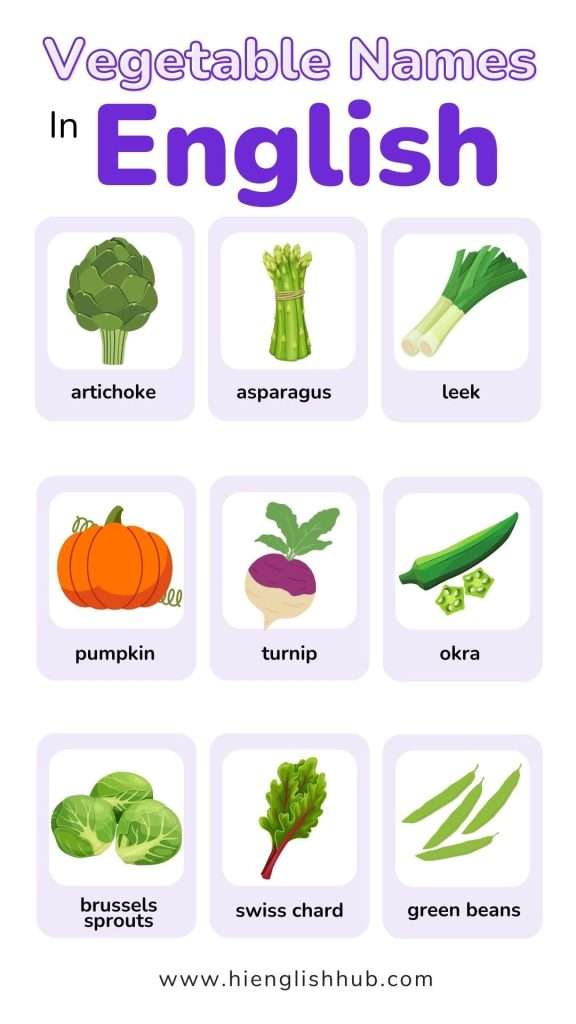
- Garlic – This is a small, white, pungent bulb used in cooking as a flavoring agent.
- Artichoke – A green vegetable that’s actually the bud of a thistle. The leaves and heart are both edible.
- Asparagus – This green vegetable is long and slender. It has a unique, strong flavor and is often steamed or grilled.
- Leek – A vegetable that’s part of the onion family but has a milder, sweeter flavor. The white and light green parts are usually used in recipes.
- Pumpkin – A round, orange vegetable often associated with fall and Halloween. It’s used in pies, soups, and other dishes.
- Turnip – A round, white, and purple root vegetable. It has a somewhat peppery flavor and can be eaten raw or cooked.
- Okra – A green vegetable that’s often used in southern and Indian cooking. It’s long and has a gooey texture when cooked.
- Brussels sprouts – These are mini cabbages that grow on a stalk. They have a somewhat bitter flavor and are often roasted.
- Swiss chard – This leafy green vegetable has a slightly bitter flavor. The stems and leaves can both be eaten.
- Green beans – They are also known as string beans or snap beans. Green beans are long, slender pods with edible seeds inside. They are commonly steamed, stir-fried, or included in casseroles and salads.
Green Leafy Vegetables: The Foundation Of Health
Have you ever wondered why Popeye loved spinach so much?
Well, it wasn’t just for the taste! Spinach, along with other green leafy vegetables like lettuce and kale, is loaded with all kinds of great stuff for your body.
We’re talking vitamins A and C, iron, and even calcium. These nutrients are super important for things like your eyesight, skin, and even your blood.
But don’t worry; you don’t need to eat them plain.
Try mixing them into a yummy salad, tossing them into a stir-fry, or blending them into a fruit smoothie.
Trust me; it’s a lot tastier than it sounds!
And the best part? You’re feeding your body with some really good stuff.
Here is a list of various green leafy vegetables:
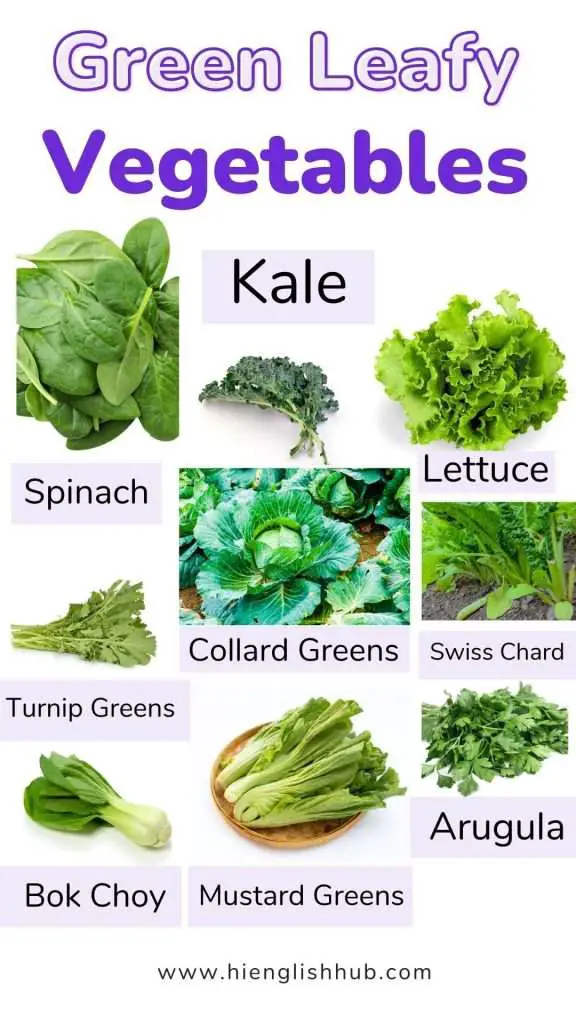
- Spinach
- Kale
- Lettuce (Romaine, Iceberg, Butterhead, etc.)
- Collard Greens
- Swiss Chard
- Arugula (also known as Rocket)
- Mustard Greens
- Bok Choy
- Turnip Greens
- Watercress
- Beet Greens
- Endive
- Chinese Cabbage (Napa Cabbage)
- Rapini (Broccoli Rabe)
- Sorrel
Root Vegetables: Underground Delights
You know, some of the tastiest treats are the ones that we don’t see at first glance, and that’s especially true with root vegetables.
These veggies are pretty shy—they hang out underground, soaking up all the good nutrients from the soil. But when you pull them up, oh boy, you’re in for a treat!
Root veggies are super versatile in the kitchen. You can roast them to bring out their sweetness, mash them for a comforting side dish, or toss them raw into a salad for a crispy bite.
And did I mention they’re also full of fiber and packed with vitamins and minerals?
So, want to know what’s lurking beneath the surface? Here are 20 awesome root veggies to explore:
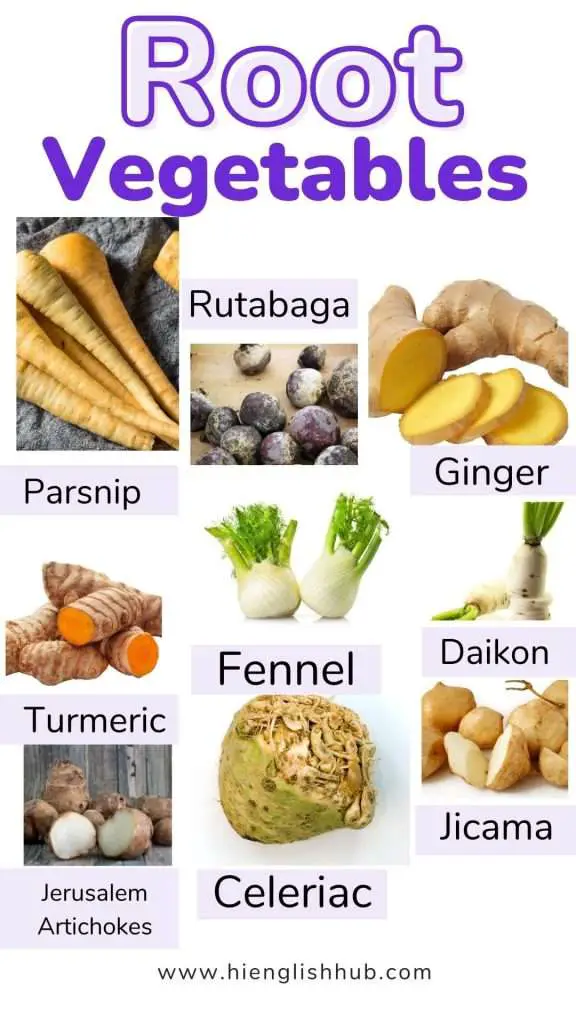
- Carrot
- Beet (or beetroot, as some people call it)
- Potato (think of all the fries and mashed potatoes you can make!)
- Sweet Potato (hello, sweet potato fries!)
- Radish (these add a spicy crunch to salads)
- Turnip (they’re great in soups)
- Parsnip (they’re like carrots but sweeter)
- Rutabaga (also known as swede)
- Ginger (it adds a kick to dishes)
- Turmeric (it’s what makes curry yellow)
- Onion (essential for almost any savory dish)
- Garlic (a kitchen staple worldwide)
- Fennel (it has a unique licorice flavor)
- Daikon (a type of radish popular in Asian cuisine)
- Jerusalem Artichokes (also known as sunchokes)
- Celeriac (or celery root, has a strong celery flavor)
- Jicama (it’s crunchy and slightly sweet)
- Horseradish (great for giving dishes some heat)
- Yam (not just for Thanksgiving!)
- Kohlrabi (it tastes a bit like broccoli stems)
Isn’t it amazing to think about all the deliciousness hidden right under our feet?
So, next time you’re at the grocery store or farmer’s market, don’t forget to check out the root veggies!
Colorful Bell Peppers: A Rainbow In Your Kitchen
You know what’s really fun? Cooking with color! And when it comes to bright, vibrant hues, bell peppers are a surefire way to jazz up your plate.
These guys aren’t just pretty to look at; they’re crunchy, they’re sweet, and they’re a great source of vitamins. They come in a rainbow of colors—each one adding its own unique flavor and charm to your dishes.
Did you ever notice that the different colors of bell peppers don’t all taste the same? That’s right! The green ones are a bit more bitter, the red ones are super sweet, and the yellow and orange ones sit somewhere in between. There are even purple and white ones too!
So, ready to add some color to your kitchen? Here are some bell pepper varieties that you might come across:
- Green Bell Peppers: They’re harvested earlier, so they’re less sweet and a bit more bitter.
- Red Bell Peppers: They’re fully ripened, which makes them the sweetest.
- Yellow Bell Peppers: These are sweet but not as sweet as red ones.
- Orange Bell Peppers: These are also quite sweet, with a slightly different flavor.
- Purple Bell Peppers: They’re less common but offer a unique color and a slightly different taste.
Cruciferous Vegetables: The Health-Boosting Powerhouses
Let’s talk about some real superheroes in the world of veggies—cruciferous vegetables. These guys are absolute powerhouses when it comes to nutrition. Packed with vitamins, fiber, and disease-fighting compounds, they’re a must-have on your plate.
And the names? You might recognize some of these as your dinner regulars: broccoli, cauliflower, Brussels sprouts. But guess what? There are even more members in this super veggie family.
Here’s a quick roll call of these health-boosting heroes:
- Broccoli
- Cauliflower
- Brussels Sprouts
- Cabbage (there’s a bunch of varieties to choose from!)
- Kale
- Bok Choy
- Collard Greens
- Radishes
- Turnips
- Watercress
- Rutabaga
- Kohlrabi
- Arugula (also known as rocket)
- Mustard Greens
- Horseradish
- Daikon
The Onion Family: Essential Flavors In Every Cuisine
And then, we have the onion family. Now, these guys are the secret superstars of the culinary world. I mean, imagine your favorite dishes without the flavor of onions, garlic, or leeks. It’s kind of tough, right?
Well, that’s because these veggies, known as alliums, add that special something to our food.
They’re so universal you’ll find them in almost every cuisine around the world!
Here’s a list of the members of the onion family you might want to get to know better:
- Onions (from sweet to sharp, they’re all here)
- Garlic (just a clove can transform a dish!)
- Leeks (they’re milder and sweeter, great in soups and stews)
- Chives (delicate onion flavor, perfect as a garnish)
- Shallots (a bit like onion and garlic had a baby)
- Scallions (also known as green onions or spring onions)
- Elephant Garlic (despite its name, it’s milder and leans closer to leeks)
Summer Squashes Vs. Winter Squashes: What’s The Difference?
Did you know there are two main types: summer squash and winter squash? And no, it doesn’t mean you can only eat them in those seasons!
Summer squashes are usually harvested when they’re immature, so their skin is tender and edible, and they have a lighter, slightly sweet flavor. Think zucchini or yellow squash.
On the other hand, winter squashes are left to fully mature, which gives them hard, tough skins, a longer shelf life, and a sweet, rich flavor. Your classic pumpkin and butternut squash? They’re both winter squashes.
Here are some common varieties you might find:
Summer Squashes:
- Zucchini
- Yellow Squash (also known as summer squash)
- Pattypan Squash
- Zephyr Squash
- Cousa Squash
Winter Squashes:
- Butternut Squash
- Acorn Squash
- Spaghetti Squash
- Pumpkin
- Kabocha Squash
- Hubbard Squash
From Vine To Table: Understanding Tomato Varieties
Tomatoes, they’re a summer favorite! But did you know there are so many varieties, each with its own flavor, size, and color?
Yep, tomatoes come in more than just red!
From tiny, sweet cherry tomatoes that are perfect for salads to big, juicy beefsteak tomatoes that make the best sandwiches, there’s a tomato out there for everyone.
Here are a few varieties to look out for:
- Cherry Tomatoes
- Grape Tomatoes
- Roma Tomatoes (also known as plum tomatoes)
- Beefsteak Tomatoes
- Heirloom Tomatoes
- San Marzano Tomatoes
- Campari Tomatoes
The Versatile World Of Beans And Legumes
Beans and legumes are not technically vegetables, but they’re often lumped in because they’re so similar.
Plus, they’re packed with protein, fiber, and tons of other nutrients.
Whether you toss them into salads, blend them into dips, or simmer them into stews, beans, and legumes are a great way to add some extra nutrition to your meals.
And there’s a whole world of them to explore!
- Black Beans
- Kidney Beans
- Pinto Beans
- White Beans (like cannellini or navy beans)
- Garbanzo Beans (also known as chickpeas)
- Lentils
- Split Peas
- Edamame (young soybeans)
- Black-eyed Peas
- Fava Beans
Spicing It Up: Pungent And Aromatic Herbs And Spices
Ever thought about how your favorite dishes would taste without any herbs or spices?
Not as exciting, right? These little guys can make a dish go from “meh” to “wow” in a jiffy!
They can be fresh or dried, and they come from all over the world. Some are fiery hot, and others are earthy, sweet, tangy, or refreshing.
But the best part is, they don’t just add flavor to your food; they also pack some pretty cool health benefits!
Here are some herbs and spices to experiment with:
- Basil
- Cilantro (also known as coriander)
- Mint
- Dill
- Oregano
- Thyme
- Rosemary
- Chives
- Parsley
- Tarragon
- Turmeric
- Cumin
- Paprika
- Cinnamon
- Nutmeg
- Cloves
- Ginger
- Chili Powder
- Garlic Powder
- Onion Powder
Exotic Vegetables: Expand Your Culinary Horizons
But why stop at familiar veggies? There’s a whole wide world of exotic vegetables out there just waiting for you to try.
Some of them might look a bit odd, and others might have unusual tastes, but they can bring some real excitement to your cooking!
Why not give these a go?
- Romanesco Broccoli: This funky veggie has a unique spiral pattern and tastes a bit like cauliflower.
- Kohlrabi: Looks strange but tastes deliciously sweet and crisp!
- Dragon Fruit: Okay, it’s a fruit, but it’s just too cool to leave out.
- Chayote: A type of squash that’s great in stir-fries.
- Daikon Radish: This giant white radish is a staple in Asian cuisine.
- Jicama: Crunchy, sweet, and perfect in salads.
- Okra: Slimy when cooked, but oh so good in stews and curries.
- Bitter Melon: Not for everyone, but worth trying for its unique flavor.
- Celeriac: This ugly duckling is actually super versatile and tasty.
- Jerusalem Artichokes: Also known as sunchokes, these are sweet and nutty.
Tips To Remember Vegetable Names In English
Do you ever find yourself in the supermarket staring at a vegetable and drawing a blank on its name?
Or perhaps you’ve been in the middle of a cooking experiment and realized you don’t know what to call the key ingredient in English?
Don’t worry; you’re not alone.
Remembering all those veggie names can be a bit of a brain workout.
But don’t fret; here are a few handy tips to help you out.
Use Flashcards: Old school? Yes. Effective? Absolutely! Write the name of the vegetable in English on one side, maybe stick a picture on the other, and voila—you have your very own custom flashcards.
Cook New Recipes: Trying out new recipes is not only fun but also a great way to learn new vegetable names. When you cook with them, you get to know them!
Shop With A List: Write down the English names of all the veggies you need before you head to the store. This will not only help you remember their names but also avoid those “ummm” moments in the middle of the veggie aisle.
Watch Cooking Shows: English-language cooking shows or YouTube channels can be a great way to learn. You’ll pick up the correct pronunciation, and you get to see the veggies being used in real-life cooking situations!
Play A Game: Make your learning fun! There are plenty of online games and quizzes that can test your knowledge and help you learn new vegetable names.
So, remember, learning new things takes time. And it’s totally okay if you forget a few names here and there.
What matters is that you keep exploring, keep cooking, and keep having fun with your food. Happy learning, everyone!
The Shortest Vegetable Name
As for the shortest vegetable name, it’s likely “pea” or “yam.” Both only have three letters.
Name Three Flowers That Are Used As Vegetables
- Broccoli: What we consume as broccoli are actually the unopened flower buds of the plant.
- Cauliflower: Similar to broccoli, cauliflower is also a flower that we eat before it blooms.
- Artichokes: An artichoke is a type of thistle whose flower bud, before it comes into bloom, is eaten as a vegetable.
Name Two Plants Whose Flowers Are Eaten As Vegetables
- Squash Blossoms: The flowers from both summer and winter squashes are edible. They can be stuffed, baked, or fried.
- Nasturtiums: These flowers have a slightly peppery taste and are often used in salads.
Name Some Vegetables That Are Actually Fruits Of The Plants
- Tomatoes: Despite being often thought of as a vegetable, a tomato is a fruit because it forms from a flower and contains seeds.
- Bell Peppers: Bell peppers, like tomatoes, form from flowers and contain seeds, classifying them as fruits.
- Cucumbers: Cucumbers also develop from flowers and contain seeds, so they’re technically fruits.
- Zucchini: Zucchinis are also classified as fruits due to the same reasons as the above.
Name Four Plants Whose Roots Are Used As Vegetables
- Carrots: The orange part we eat is the root of the plant.
- Beets: Beetroots are the root of the plant and are often eaten boiled, roasted, or raw.
- Parsnips: Parsnips are a root vegetable closely related to carrots.
- Radishes: Radishes are also root vegetables, often eaten raw in salads.
FAQs On Vegetable Names
What Is The English Name For The ‘Began’ Vegetable?
The English name for the vegetable “began” is “Eggplant.” In the UK and other countries, it is also known as “aubergine.”
What Are 20 Types Of Vegetables?
Here are twenty types of vegetables:
1. Broccoli
2. Carrots
3. Spinach
4. Potatoes
5. Tomatoes
6. Zucchini
7. Cabbage
8. Asparagus
9. Cauliflower
10. Bell peppers
11. Brussels sprouts
12. Beetroots
13. Cucumbers
14. Onions
15. Garlic
16. Radishes
17. Kale
18. Lettuce
19. Pumpkin
20. Sweet potatoes
What Is The English Name For Zucchini?
The English name for zucchini remains the same. However, it is called “courgette” in the UK, Ireland, and other countries that use British English.
What Are The Top 10 Best Vegetables?
While it can vary depending on personal preference and nutritional needs, here are ten vegetables that are often recognized for their health benefits:
1. Spinach
2. Kale
3. Broccoli
4. Brussels sprouts
5. Peas
6. Sweet potatoes
7. Bell peppers
8. Carrots
9. Garlic
10. Beetroot
What Are The 10 Most Popular Vegetables?
Popularity can vary by region, but in the United States, for example, these are among the most popular vegetables:
1. Potatoes
2. Tomatoes
3. Onions
4. Carrots
5. Broccoli
6. Bell peppers
7. Lettuce
8. Cucumbers
9. Celery
10. Corn
What Do Americans Call Brussels Sprouts?
In America, Brussels sprouts are simply called “Brussels sprouts.”
What Do Americans Call Beetroot?
In America, beetroot is often simply referred to as “beets.”

